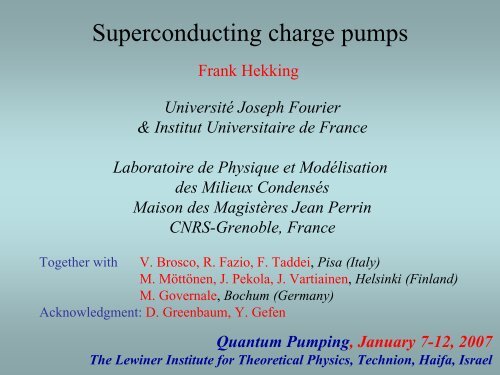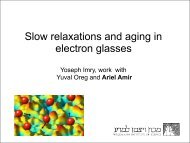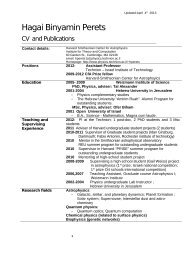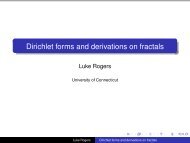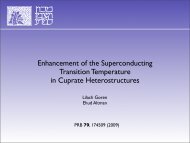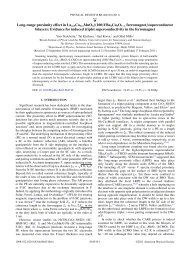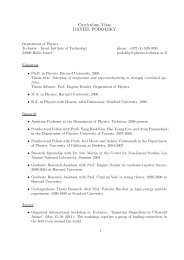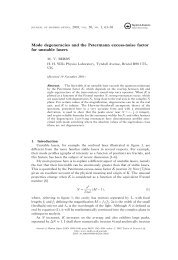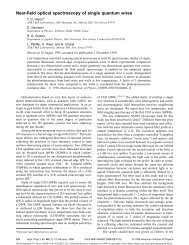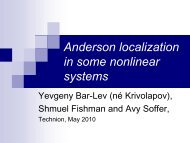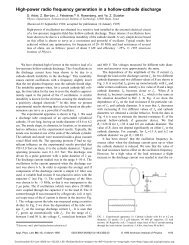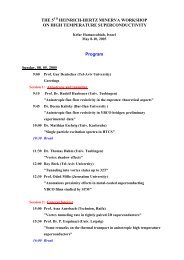Frank Hekking - Physics@Technion
Frank Hekking - Physics@Technion
Frank Hekking - Physics@Technion
Create successful ePaper yourself
Turn your PDF publications into a flip-book with our unique Google optimized e-Paper software.
Superconducting charge pumps<br />
<strong>Frank</strong> <strong>Hekking</strong><br />
Université Joseph Fourier<br />
& Institut Universitaire de France<br />
Laboratoire de Physique et Modélisation<br />
des Milieux Condensés<br />
Maison des Magistères Jean Perrin<br />
CNRS-Grenoble, France<br />
Together with V. Brosco, R. Fazio, F. Taddei, Pisa (Italy)<br />
M. Möttönen, J. Pekola, J. Vartiainen, Helsinki (Finland)<br />
M. Governale, Bochum (Germany)<br />
Acknowledgment: D. Greenbaum, Y. Gefen<br />
Quantum Pumping, January 7-12, 2007<br />
The Lewiner Institute for Theoretical Physics, Technion, Haifa, Israel
Introduction & Motivation<br />
Outline<br />
Adiabatic charge transfer in Cooper pair pumps<br />
- Relation between pumped charge and geometric phase<br />
Open Cooper pump<br />
-Adiabatic manipulation of Andreev bound states<br />
Closed Cooper pump<br />
-Effect of measuring device on pumped charge<br />
Conclusion
Introduction & Motivation
Parametric pumping in the normal state<br />
« Open » systems « Closed » systems<br />
(Brouwer PRB98)<br />
- modulation of transmission phase<br />
- electronic phase coherence crucial<br />
- interactions weak<br />
- non-integer number of electrons per cycle<br />
(Thouless PRB83, Brouwer PRB98<br />
Switkes et al. Science99)<br />
(Zorin JAP00)<br />
- modulation of Coulomb blockade<br />
- interactions crucial (charge quantization)<br />
- interference effects weak<br />
- integer number of electrons per cycle<br />
(Delft-Saclay, NIST Boulder<br />
PTB Braunschweig, TKK Helsinki)
Normal three-junction pump<br />
Central idea: controlled charge transfer<br />
upon gate modulation<br />
I = e f
Experiment (Delft-Saclay)<br />
(Pothier et al. EPL92)
Single Cooper pair pump (Delft-Saclay)<br />
(Geerligs et al., ZPB ’91)
Revived interest in superconducting pumps<br />
Metrology:<br />
operation of normal state multijunction pumps limited by RC-time<br />
- Pekola et al. PRB99: theory of coherent charge transfer<br />
- Zorin et al. cond-mat00: experiment on a resistive pump<br />
- Vartiainen et al, cond-mat 06, nanoampere pumping of Cooper pairs<br />
Quantum information processing:<br />
adiabatic manipulation of individual Cooper pairs<br />
- Averin cond-mat97: adiabatic quantum computing with Cooper pairs<br />
- Falci et al., Science 00: geometricJosephson qubits<br />
- Ioffe & Feigelman PRB02: protected Josephson qubits<br />
- Bibow et al . PRL02: experiment on resonant tunnelling through coherent charge states
Adiabatic charge transfer in Cooper pair pumps<br />
Relation between pumped charge and geometric phase<br />
Möttönen et al, PRB06<br />
Brosco et al., unpublished
Adiabatic charge transfer in Cooper pair pumps<br />
H(t) = H(Φ, {λ i(t)})<br />
Phase difference across pump<br />
Control parameters<br />
Adiabatic transfer of Cooper pairs is obtained by slow periodic modulation of<br />
control parameters
Adiabatic expansion<br />
Solution of Schrödinger equation up to first<br />
order in 1/T<br />
T denotes the duration of a<br />
pumping cycle<br />
Dynamical contribution, O(T) Geometrical<br />
contribution, O(0)
Instantaneous eigenstates<br />
Initial condition<br />
Instantaneous eigenstates<br />
Expansion in terms of instantaneous eigenstates<br />
Dynamical phase Berry phase
Charge pumped in a cycle of duration T<br />
Dynamical<br />
contribution, O(T)<br />
Geometrical<br />
contribution, O(0)<br />
Berry phase
First example: « open » Cooper pump<br />
Adiabatic manipulation of Andreev bound states<br />
Governale et al, PRL05
−φ/2<br />
Δ0 Hamiltonian<br />
0<br />
0<br />
Open SNS pump<br />
φ(r)<br />
Δ(r)<br />
φ/2<br />
Δ 0
Andreev bound states in the absence of normal<br />
scattering<br />
Plane-wave solutions for particles and holes<br />
Matching yields discrete spectrum<br />
(Kulik, Sov. Phys. JETP70)<br />
NS interface:<br />
Andreev reflection process<br />
χ<br />
Scattering amplitude: α e<br />
±i χ
Andreev bound states in the presence of normal<br />
scattering<br />
(Beenakker, Les Houches 94)<br />
Andreev reflection<br />
Phase factor<br />
Normal scattering<br />
Normal state scattering matrix
Andreev bound states in a short single channel pump<br />
Schrödinger equation<br />
Instantaneous eigenstates<br />
If W < ξ 0<br />
States above the gap do not contribute to current
Dynamical contribution, O(T)<br />
Pumped charge<br />
Geometrical contribution, O(0)
Results<br />
Difference in scales<br />
Q Jos(φ) is O(T), Q p(φ) is O(1)<br />
Parity:<br />
Q Jos(φ) odd, Q p(φ) even<br />
Measure Q(φ)+Q(−φ)<br />
Adiabaticity condition
Second example: « closed » Cooper pair pump<br />
Effect of measuring device<br />
on geometrically pumped charge<br />
Fazio et al, PRB03
Superconducting three-junction pump<br />
Charging energy dominates!
Charging energy: stability diagram
Josephson coupling: coherent mixing of charge states
Results
(Pekola et al. PRB99)<br />
Coherent Cooper pair pump<br />
Triangular gating sequence<br />
incoherent classical<br />
contribution<br />
coherent correction<br />
Interference due to higher order process
Pump: current generates<br />
flux through SQUID<br />
SQUID: critical current<br />
depends on flux<br />
Two possible measuring circuits<br />
Pump: current generates extra<br />
current through escape junction<br />
Escape junction in quantum limit:<br />
voltage sensitive to small current changes<br />
I (μA)<br />
15<br />
10<br />
5<br />
0<br />
-5<br />
-10<br />
-15<br />
V=0<br />
V~2Δ/e<br />
-0.6 -0.4 -0.2 0 0.2 0.4 0.6<br />
Uech (mV)
Measurement circuit: the model<br />
Phase across junction fluctuates<br />
Physics governed by partition function
Integrate out circuit degrees of freedom<br />
Here<br />
Second order: interaction term<br />
Effective theory<br />
First order: renormalized Josephson coupling<br />
where
up to a frequency ω c<br />
RG-analysis:<br />
Resistive environment<br />
Effect on pumped charge<br />
where<br />
logarithmic divergence!<br />
low energy cut-off ω 0 = max (f, eV, …)
Coulomb blockade<br />
lifted at finite bias<br />
Resistive Cooper pair pump<br />
(Zorin, cond-mat00)<br />
Coulomb blockade at<br />
zero bias
α = ω<br />
LCL LCL<br />
s/R s/R<br />
Measurement with a SQUID loop<br />
Frequency-dependent impedance<br />
γ = M 2 /(L s L)<br />
Renormalized Josephson coupling<br />
independent of low energy cut-off!
η 0 R K/ω LCL J<br />
0.8<br />
0.7<br />
0.6<br />
0.5<br />
0.4<br />
0.3<br />
0.2<br />
Measurement with an escape junction<br />
2 4 6 8 10 12 14<br />
α = ωLCLJ/R Value of R: trade-off hysteresis-fluctuations<br />
Frequency-dependent<br />
impedance<br />
Renormalized Josephson coupling<br />
independent of low energy cut-off!
Conclusions<br />
Adiabatic charge transfer in Cooper pair pumps<br />
- Relation between pumped charge and geometric phase<br />
“Open” Cooper pump<br />
-Adiabatic manipulation of Andreev bound states<br />
“Closed” Cooper pump<br />
-Effect of measuring device on pumped charge:<br />
suppression of Josephson energy<br />
Examples<br />
-Resistive environment: efficiently suppresses coherent part<br />
-Inductive environment: coherent part survives<br />
-SQUID<br />
-Escape junction


